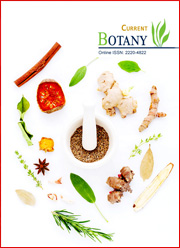Phytochemical profiling, antibacterial, antifungal and antioxidant evaluation of Acrotrema arnottianum Wight - An ethnomedicinal plant
DOI:
https://doi.org/10.25081/cb.2025.v16.9558Keywords:
Acrotrema arnottianum, Flavonoids, GC-MS, Antibacterial, Antifungal, Phenols, Squalene, Eugenol, CampesterolAbstract
Acrotrema arnottianum Wight (Dilleniaceae) is a perennial herb that grows in damp, shaded areas. It is native to the Western Ghats of Kerala and Tamil Nadu, where it is used in traditional medicine by tribal people, including the Malavedans of Kerala, to treat baldness and hair loss. Histochemical localisation of stem, petiole and midrib was performed to determine the localisation of flavonoids, phenols, alkaloids and tannins. The results indicated the presence of flavonoids and phenols. GC-MS analysis of ethanol extract revealed the presence of metabolites such as Linoleic acid, ethyl oleate, campesterol, tetradecanoic acid, Hexadecanoic acid, 3,7,11,15-Tetramethyl-2-hexadecen-1-ol, squalene and α-Tocopherol. GC-MS analysis of ethyl acetate extract showed the presence of α-Tocopherol-β-D-Mannoside, 3,7,11,15-Tetramethyl-2-hexadecen-1-ol, squalene, diphenols, phytol, eugenol and β-sitosterols. The antibacterial study against Staphylococcus aureus showed that ethyl acetate extract is more potent in inhibiting the growth (17±0.18) while the antifungal study against Candida albicans showed that ethyl acetate has a significant effect in inhibiting the growth (16±0.23), in dosage dependent manner. The antioxidant study revealed that ethanol extract has a higher IC50 value of 36.02±0.27. This study indicates that Acrotrema arnottianum is a source of pharmaceutically active secondary metabolite compounds.
Downloads
References
Aparna, V., Dileep, K. V., Mandal, P. K., Karthe, P., Sadasivan, C., & Haridas, M. (2012). Anti-inflammatory property of n-hexadecanoic acid: structural evidence and kinetic assessment. Chemical Biology & Drug Design, 80(3), 434-439. https://doi.org/10.1111/j.1747-0285.2012.01418.x
Choi, J. M., Lee, E. O., Lee, H. J., Kim, K. H., Ahn, K. S., Shim, B. S., Kim, N. I., Song, M. C., Baek, N. I., & Kim, S. H. (2007). Identification of Campesterol from Chrysanthemum coronarium L. and its antiangiogenic activities. Phytotherapy Research, 21(10), 954-959. https://doi.org/10.1002/ptr.2189
Dan, S., & Dan, S. S. (1980). Triterpenoids of Indian Dilleniaceae. Journal of the Indian Chemical Society, 57, 760.
Das, B., Yeger, H., Baruchel, H., Freedman, M. H., Koren, G., & Baruchel S. (2003). In vitro cytoprotective activity of squalene on a bone marrow versus neuroblastoma model of cisplatin-induced toxicity: implications in cancer chemotherapy. European Journal of Cancer, 39(17), 2556-2565. https://doi.org/10.1016/j.ejca.2003.07.002
Dickson, C. W. (1971). Comparative morphological studies in Dilleniaceae, VII. Additional notes on Acrotrema. Journal of the Arnold Arboretum, 52(2), 319-333. https://doi.org/10.5962/p.333905
Fox, C. B. (2009). Squalene emulsions for parenteral vaccine and drug delivery. Molecules, 14(9), 3286-3312. https://doi.org/10.3390/molecules14093286
Furr, M., & Mahlberg, G. P. (1981). Histochemical Analyses of Laticifers and Glandular Trichomes in Cannabis sativa. Journal of Natural Products, 44(2), 153-159. https://doi.org/10.1021/np50014a002
Gurni, A. A., & Kubitzki, K. (1981). Flavonoid Chemistry and Systematics of the Dilleniaceae. Biochemical Systematics and Ecology, 9(2-3), 109-114. https://doi.org/10.1016/0305-1978(81)90028-4
Huang, W. Y., Cai, Y. Z., & Zhang, Y. (2009). Natural phenolic compounds from medicinal herbs and dietary plants: potential use for cancer prevention. Nutrition and Cancer, 62(1), 1-20. https://doi.org/10.1080/01635580903191585
Johansen, D. A. (1940). Plant Microtechnique. New York, US: McGraw-Hill.
Kumar, V. S. A., Sunila, A. V., Kumar, S. A., Krishnan, R., & Greeshma, R. B. (2018). Bio potentials of Acrotrema arnottianum Wight- an endemic medicinal herb of southern Western Ghats of Kerala, south India. World Journal of Pharmacy and Pharmaceutical Sciences, 7(2), 1052-1063.
Kumari, J. U., Navas, M., Dan, M., & Rajasekharan, S. (2009). Pharmacognostic studies of Acrotrema arnottianum Wight- a promising ethnomedicinal plant. Indian Journal of Traditional Knowledge, 8(3), 334-337.
Lima, C. C., Lemos, P. L. R., & Conserva, M. L. (2014). Dilleniaceae family: an overview of its ethnomedicinal uses, biological and phytochemical profile. Journal of Pharmacognosy and Phytochemistry, 3(2), 181-204.
Mathew, J., & George, V. (2006). Bioactive compounds from Acrotrema arnottianum. Asian Journal of Chemistry, 18(4), 2747-2755.
Mercola, J., & D’Adamo, R. C. (2023). Linoleic acid: A narrative review of the effects of increased intake in the standard American diet and associations with chronic disease. Nutrients, 15(14), 3129. https://doi.org/10.3390/nu15143129
Mohanan, M., & Henry, A. N. (1994). Flora of Thiruvananthapuram (Vol. 1, pp. 41-42). Calcutta, India: Botanical Survey of India.
Nisar, M. F., Khadim, M., Rafiq, M., Chen, J., Yang, Y., & Wan, C. C (2021). Pharmacological properties and health benefits of Eugenol: a comprehensive review. Oxidative Medicine and Cellular Longevity, 2021(1), 2497354. https://doi.org/10.1155/2021/2497354
Pagare, S., Bhatia, M., Tripathi, N., Pagare, S., & Bansal, Y. K. (2015). Secondary metabolites of plants and their role: Overview. Current Trends in Biotechnology and Pharmacy, 9(3), 293-304.
Pratiwi, R. D., Ratnadewi, D., & Sulistyaningsih, Y. (2020). Localization of alkaloid and other secondary metabolites in Cinchona ledgeriana Moens: Anatomical and histochemical studies on fresh tissues and cultured cells. HAYATI Journal of Biosciences, 27(1), 1-7. https://doi.org/10.4308/hjb.27.1.1
Rashed, K. (2020). Beta-sitosterol medicinal properties: a review article. International Journal of Science Inventions Today, 9(4), 208-212.
Savithramma, N., Rao, M. L., & Venkateswarlu, P. (2014). Histochemical studies of Boswellia ovalifoliolata Bal. & Henry – An endemic, endangered and threatened medicinal plant of Seshachalam hill range of Eastern Ghats of India. International Journal of Pharmacognosy and Phytochemical Research, 6(1), 1-6.
Selvan, P. S., & Velavan, S. (2015). Analysis of bioactive compounds in methanol extract of Cissus vitiginea leaf using GC-MS technique. RASAYAN Journal of Chemistry, 8(4), 443-447.
Somat, A. N., Osman, P. C., Ismail, H. N., Yusoff, Z., & Yusof, M. Y. (2019). Screening of medicinal plants from Taman Herba Perlis for acetylcholinesterase inhibitory activity. Science Letters, 13(1), 23-32.
Umashankar, D. D. (2020). Plant secondary metabolites as potential usage in regenerative medicine. The Journal of Phytopharmacology, 9(4), 270-273. https://doi.org/10.31254/phyto.2020.9410
Published
How to Cite
Issue
Section
Copyright (c) 2025 Akhil Ashokan, S. Sreeranjini

This work is licensed under a Creative Commons Attribution-NonCommercial 3.0 Unported License.



 .
.